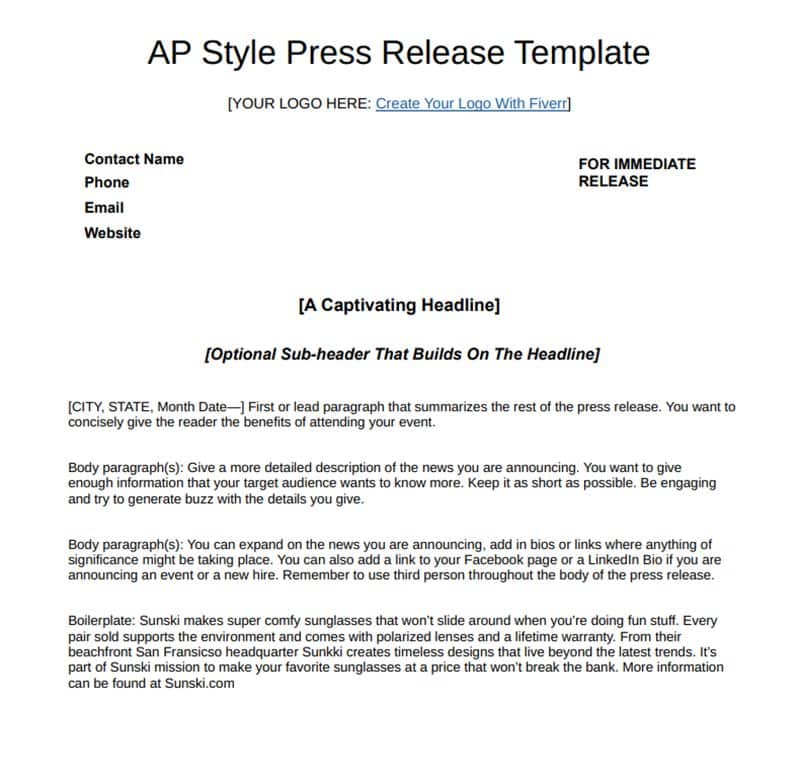
An AP style press release is one that follows AP (Associated Press) guidelines. Learning how to write an AP style press release gives your release an advantage. Since it’s already in the journalist-preferred format, it’s essentially ready to publish. So for journalists on a tight deadline, this could be the difference in whether or not to pick up your story for additional coverage.
Below you’ll find a template that follows AP guidelines as well as the steps for how to write your press release:
Established in 1846, the Associated Press (AP) is one of the largest, most trusted news agencies worldwide. Every year it publishes an AP Stylebook that governs how they want journalists to format content so that everything is uniform, no matter who writes the story.
The style guide covers everything about how to write an AP style press release from formatting conventions to punctuation rules. And as the media evolves, so does the guide. For example, last year they added a chapter on inclusive storytelling, added or revised 35 disability-related entries, and updated topics like immigration, gender and sexual orientation, religion, race, and more.
Here are some key AP formatting guidelines for press releases:
You can also learn how to write an AP style press release by using our template. It follows the proper press release format structure to ensure that media outlets, journalists, and search engines can find important information quickly.
Download the AP style press release template below then use it as you follow the remaining steps for how to write an AP style press release. You’ll find options for downloading the template for Microsoft Word, opening a Google Doc and saving a copy, or downloading it as a PDF.
FILE TO DOWNLOAD OR INTEGRATE
AP Style Press Release Template
Download as Word Doc Download as PDF Download as Google Doc
💡 Quick Tip: When you’re ready to distribute your press release, use our #1 recommended press release distribution service for small businesses: EIN Presswire, starting from $99.
Select Download TypeDid you know? The news media aren’t the only ones that follow AP style guidelines for writing content. Many blogs and websites also base their content guides on AP style and simply adapt it with any exceptions they prefer.
Before writing a press release, identify the best angle for your story based on the audience you want to engage and the journalists you want to cover your news. Keep in mind when approaching the media that the audience is not just journalists, but their readers, listeners, and social media and email followers as well.
Try using our free customer persona template to better hone in on your ideal audience types to come up with the best angle for your press release.
Once you’ve found an angle for your story and media pitch, it’s time to start writing your press release. As you do, incorporate details into your press release’s headlines and text that reflect the angle by explaining why your news matters to your intended audience.
If you’re unsure of how to write a press release or having trouble finding a newsworthy angle, you’re not alone. Turning the task over to media-seasoned professionals who can not only format your story but also “zhuzh it up” can give your story an additional edge, making it more likely to receive additional media coverage.
If you’re looking for help like this, you can get your story professionally written and ensure that it’s in AP style format by using a press release writing service like eReleases. They’ll also distribute your announcement to a wide audience, including direct-to-media emails, giving it an even better chance of landing coverage.
At the very top center of the press release, add your business logo. Next, on the left-hand side, put your contact information. Include the following information in this order, with each on a new line:
On the right-hand side, add your release instructions. These include the time and date when you want your announcement to be published. It should be in all caps.
If your press release is ready to be distributed immediately, include the words “FOR IMMEDIATE RELEASE” at the top of your press release. If you want the media to hold onto your press release for a certain time period, it is called an “embargoed” release. In that case, write “EMBARGOED FOR RELEASE UNTIL [DATE AND TIME].”
To write an AP style press release, the headline should be at the top-center of your press release in Title case (for capitalization) just below the header section we created in the last step. It should be between 65 and 80 characters and in 14-point font size.

An example of a good headline for an AP style press release
(Source: M&T Bank via PRNewswire)

This headline example is compelling because of its timely “in time for holiday” marketing.
(Source: JoinBrands via PRNewswire)

This headline creates intrigue to learn more. (Source: Clever via PRNewswire)
Since the headline is usually the most eye-catching part of your press release, it should intrigue people so that they want to read the rest of your press release. Here are some effective approaches for writing a headline:
Next, add a subheadline just below the main headline to provide additional insights or details. Subheadings are usually about 80 to 120 characters in length and appear directly below your headline.

The subheadline should be formatted in 13-point Times New Roman font and in title case to comply with AP style formatting, and be italicized to draw your reader’s attention. The subheadline gives you another opportunity to grab the attention of journalists with your story’s angle and incorporate search-friendly keywords.
The first paragraph of your press release (sometimes called the “lead”) should be under 60 words and starts with the release date and location. The lead paragraph should be a concise summary of the most important information in your story, including the date and location.

An example of a press release with a headline and subheadline (Source: Expion via PRNewswire)
The first paragraph should begin with the date you want the release to go live and the city in which the press release originated. Many media outlets consider these details when deciding whether to pick up your press release. For example, you’ll often see notations like this that begin the first paragraph of a release:
SANTA MONICA, Calif. (Sept. 26, 2023) —
Put these elements in 12 pt bold font and use the proper format for state abbreviations, noting that eight states (Alaska, Hawaii, Idaho, Iowa, Maine, Ohio, Texas, and Utah) are never abbreviated. Below is a list of state abbreviations for AP style press releases, plus for Washington, D.C. (the District of Columbia):